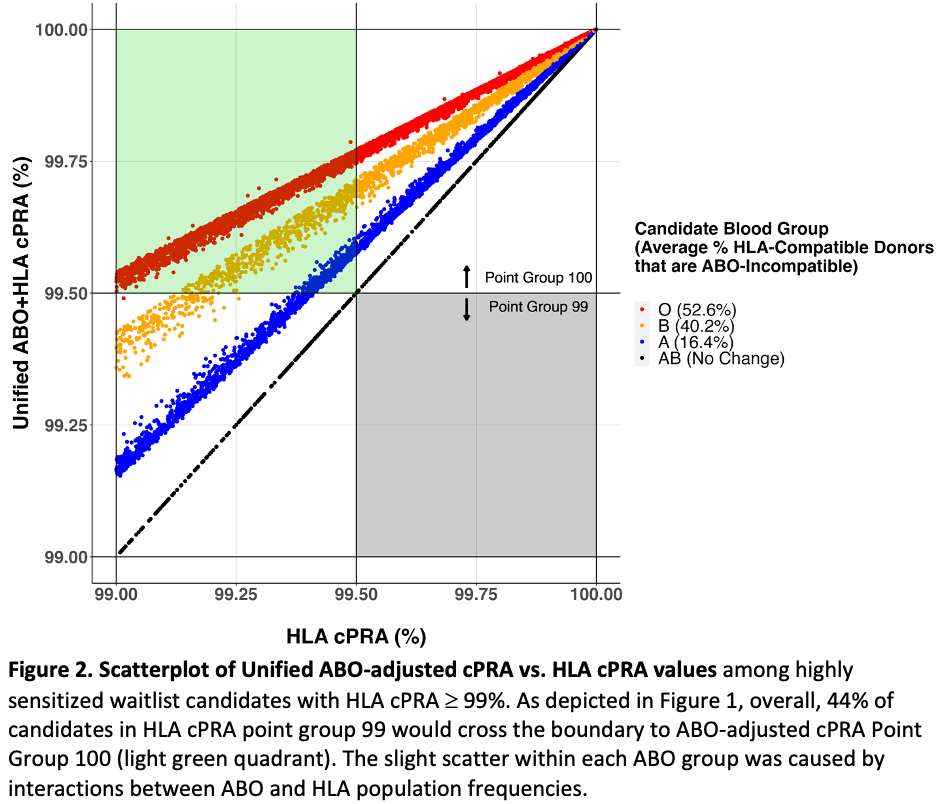“ABO-Adjusted CPRA”: A Unified Metric for Immunologic Compatibility in Kidney Transplantation
1Tulane University, New Orleans, LA, 2University of British Columbia, Vancouver, BC, Canada, 3UNOS, Richmond, VA, 4Dalhousie University, Halifax, NS, Canada, 5Emory University, Atlanta, GA, 6Cedars-Sinai, Beverly Hills, CA
Meeting: 2022 American Transplant Congress
Abstract number: 12
Keywords: Alloantigens, HLA antibodies, Natural antibodies, Organ Selection/Allocation
Topic: Clinical Science » Kidney » 31 - Kidney Deceased Donor Allocation
Session Information
Session Name: Kidney Deceased Donor Allocation
Session Type: Rapid Fire Oral Abstract
Date: Sunday, June 5, 2022
Session Time: 3:30pm-5:00pm
 Presentation Time: 4:40pm-4:50pm
Presentation Time: 4:40pm-4:50pm
Location: Hynes Ballroom C
*Purpose: Implementation of the kidney allocation system in 2014 greatly reduced access disparity due to HLA sensitization. To address persistent disparities among both candidate cPRA and ABO blood groups, we propose a unified cPRA metric which simultaneously considers the impact of candidate HLA and ABO sensitization on the same scale.
*Methods: An ethnic-weighted ABO-adjusted cPRA value was computed, incrementing the HLA cPRA by the remaining fraction of HLA-compatible donors that are ABO-incompatible. For example, a patient with HLA-A2 antibody who is blood group O would have an HLA cPRA of 45.9%, but based on A+B+AB phenotype frequencies 52.6% of HLA-compatible donors are ABO-incompatible, giving a unified cPRA of 74.3%. (Calculator available at http://transplanttoolbox.org/abo_hla_cpra).
*Results: Consideration of ABO sensitization resulted in a higher unified cPRA relative to HLA cPRA, except for AB candidates who are not ABO-sensitized. Plotting 148,520 candidate waitlistings from post-KAS until June 30, 2017, we observed widely variable impacts (Fig 1), with the largest absolute increase in cPRA for blood group O candidates who were not HLA-sensitized. Capturing the variable impact of candidate ABO could more equitably determine allocation points, especially for highly sensitized candidates near point group boundaries. Within HLA cPRA Point Group 99, overall 44% of candidates would move up to ABO-adjusted cPRA Point Group 100, though this proportion varied substantially by candidate ABO blood group (Fig 2). Nearly all O candidates would move up, along with most B candidates, but relatively few A candidates.
*Conclusions: ABO-adjusted cPRA measures the proportion of immune-compatible donors more accurately than conventional HLA cPRA alone. This tool might enable development of allocation policies that would allow for more ABO-compatible transplants and improve equity for candidates currently disadvantaged by both HLA sensitization and their ABO blood group.
To cite this abstract in AMA style:
Gragert L, Kadatz M, Alcorn J, Stewart D, Chang D, Gill J, Liwski R, Gebel H, Kransdorf E, Gill J, Lan J. “ABO-Adjusted CPRA”: A Unified Metric for Immunologic Compatibility in Kidney Transplantation [abstract]. Am J Transplant. 2022; 22 (suppl 3). https://atcmeetingabstracts.com/abstract/abo-adjusted-cpra-a-unified-metric-for-immunologic-compatibility-in-kidney-transplantation/. Accessed January 1, 2026.« Back to 2022 American Transplant Congress


